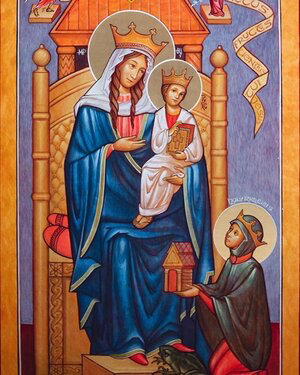Text from The Saint Andrew Daily Missal,
unless otherwise stated.
Tuesday in Passion Week.
Station at Saint Cyriacus's.
Indulgence of 10 Years and 10 Quarantines.
Violet Vestments.
English: Basilica of Santa Maria-in-Via-Lata, Rome.
Italiano: Roma, Santa Maria-in-Via-Lata.
Photo: December 2006.
Source: Own work.
Author: Lalupa
(Wikimedia Commons)
The Church, today, unites the memory of a Martyr with that of The Passion of Jesus, in making The Lenten Station in The Church of The Holy Deacon, Cyriacus, Martyred, under Emperor Diocletian, at The Gates of Rome.
This Church, one of the twenty-five Parish Churches of Rome in the 5th-Century A.D., having been destroyed by fire, the body of The Holy Martyr was Translated to beneath The High Altar of Santa Maria-in-Via-Lata, which became The Place of Assembly for this day.
The Epistle and Gospel tell us of the approaching Passion of The Messiah and of The Rejection of Israel, who are replaced by The Gentiles in The Church.
“Daniel, who has destroyed Bel and slain the Dragon” (Epistle), is Jesus, Who denounces the crimes and sins of the World (Gospel). The Babylonians sought to destroy the Prophet, by throwing him as food to the hungry lions. The Jews, also, “sought to kill Jesus” and, for this dark design, “their hour is always at hand”.
But, like Daniel, full of fortitude, He awaits The Lord (Introit), and God, “Who does not abandon those who love and seek Him” (Epistle, Offertory), “delivers Him from unjust men and from all the ills that threaten Him” (Gradual, Communion). “Those who had wished to destroy Daniel were themselves thrown to the lions and devoured instantly” (Epistle). In the same way, the Deicide Nation suffered the penalty of its crime. Forty years later, Jerusalem was taken, by The Roman Legions, after five long months of famine.
Fearing the chastisements of Divine Justice, let us persevere in the expiatory practice of Fasting, in order that we may be made worthy of The Eternal Reward accorded to The Just (Collect).
Mass: Exspécta Dóminum.
Preface: Of The Holy Cross.
The following Text is from Wikipedia - the free encyclopædia.
Santa Maria-in-Via-Lata is a Church on the Via del Corso (the ancient Via Lata), in Rome. It stands diagonally across from the Church of San Marcello-al-Corso.
It is claimed that Saint Paul spent two years here, in the Crypt under the Church, whilst under house arrest waiting for his trial.
The first Christian place of worship here was a 5th-Century A.D. Oratory, in the Roman building beneath the present Church. This was constructed within the remains of a large Roman warehouse, some 250 metres long, which has also been excavated. The Church's Upper Level was added in the 9th-Century A.D., and murals added to the Lower Level between the 7th- and 9th-Centuries A.D., (these have been detached for conservation reasons). The Cosmatesque Pavement from this phase survives.
The Church's 13th-Century icon of The Virgin Advocate, is said to have performed many Miracles. The Arcus Novus (an Arch erected by Emperor Diocletian in 303 A.D. - 304 A.D.), which stood on this site, was destroyed by rebuilding of the Church in the Late-15th-Century. Antonio Tebaldeo, poet and friend of Raphæl, was buried at the end of the North Aisle in 1537, though his tomb was designed in 1776.
The Church was renovated in 1639 by Cosimo Fanzago, but the facade, with its Corinthian Columns imposing vertical emphasis, was completed (1658-1660) by a design from Pietro da Cortona. He appears to evoke a Triumphal Arch in the facade.
The High Altar's Madonna Advocata (1636) is one of the few paintings in Churches attributed to Bernini (perhaps by Santi Ghetti). The Ciborium in the Apse is made from alabaster and lapis lazuli. The first excavations of the site also occurred at this date, as commemorated by a Relief in the Crypt by Cosimo Fancelli. The families of Joseph and Lucien Bonaparte were buried here in the 18th-Century.
The first Altarpiece is a Martyrdom of Saint Andrew (1685), by Giacinto Brandi, while the second Altarpiece is of Saints Giuseppe, Nicola, and Biagio, by Giuseppe Ghezzi. In the Chapel, to the Left of the Apse, is a Madonna with Child and Saints Cyriac and Catherine, by Giovanni Odazzi.
The second Altar, on the Left, has a Saint Paul Baptising Sabine and Children, by Pier Leone Ghezzi, while the first Altarpiece is a Virgin and Saints, by Pietro de Pietri.
The Epistle and Gospel tell us of the approaching Passion of The Messiah and of The Rejection of Israel, who are replaced by The Gentiles in The Church.
“Daniel, who has destroyed Bel and slain the Dragon” (Epistle), is Jesus, Who denounces the crimes and sins of the World (Gospel). The Babylonians sought to destroy the Prophet, by throwing him as food to the hungry lions. The Jews, also, “sought to kill Jesus” and, for this dark design, “their hour is always at hand”.
Basilica of Santa Maria-in-Via-Lata, Rome.
Photo: 26 March 2014.
Source: Own work.
Author: Miguel Hermoso Cuesta
(Wikimedia Commons)
But, like Daniel, full of fortitude, He awaits The Lord (Introit), and God, “Who does not abandon those who love and seek Him” (Epistle, Offertory), “delivers Him from unjust men and from all the ills that threaten Him” (Gradual, Communion). “Those who had wished to destroy Daniel were themselves thrown to the lions and devoured instantly” (Epistle). In the same way, the Deicide Nation suffered the penalty of its crime. Forty years later, Jerusalem was taken, by The Roman Legions, after five long months of famine.
Fearing the chastisements of Divine Justice, let us persevere in the expiatory practice of Fasting, in order that we may be made worthy of The Eternal Reward accorded to The Just (Collect).
Mass: Exspécta Dóminum.
Preface: Of The Holy Cross.
English: Engraving of the Minor Basilica of Saint Cyriacus
(Santa Maria-in-Via-Lata).
Italiano: Santa Maria-in-Via-Lata.
Engraver: Giuseppe Vasi (1710-1782).
Source: https://www.artsy.net/artwork/
Author: Giuseppe Vasi (1710-1782).
(Wikimedia Commons)
English: Santa Maria-in-Via-Lata, Rome.
Italiano: Roma, s. Maria-in-Via-Lata.
Photo: 20 June 2010.
Source: Own work.
Author: Lalupa
(Wikimedia Commons)
Santa Maria-in-Via-Lata is a Church on the Via del Corso (the ancient Via Lata), in Rome. It stands diagonally across from the Church of San Marcello-al-Corso.
It is claimed that Saint Paul spent two years here, in the Crypt under the Church, whilst under house arrest waiting for his trial.
English: The Church of Santa Maria-in-Via-Lata, Rome.
Italiano: Chiesa di Santa Maria in Via Lata, Roma.
Facciata di Pietro da Cortona
Photo: 17 October 2005.
Source: Flickr https://www.flickr.com/photos/antmoose/54074278
Author: Anthony Majanlahti.
(Wikimedia Commons)
The first Christian place of worship here was a 5th-Century A.D. Oratory, in the Roman building beneath the present Church. This was constructed within the remains of a large Roman warehouse, some 250 metres long, which has also been excavated. The Church's Upper Level was added in the 9th-Century A.D., and murals added to the Lower Level between the 7th- and 9th-Centuries A.D., (these have been detached for conservation reasons). The Cosmatesque Pavement from this phase survives.
The Church's 13th-Century icon of The Virgin Advocate, is said to have performed many Miracles. The Arcus Novus (an Arch erected by Emperor Diocletian in 303 A.D. - 304 A.D.), which stood on this site, was destroyed by rebuilding of the Church in the Late-15th-Century. Antonio Tebaldeo, poet and friend of Raphæl, was buried at the end of the North Aisle in 1537, though his tomb was designed in 1776.
"The Virgin Advocate",
Church of Santa Maria-in-Via-Lata, Rome.
Photo taken from Google Images and cryptavialata.it
The Church was renovated in 1639 by Cosimo Fanzago, but the facade, with its Corinthian Columns imposing vertical emphasis, was completed (1658-1660) by a design from Pietro da Cortona. He appears to evoke a Triumphal Arch in the facade.
The High Altar's Madonna Advocata (1636) is one of the few paintings in Churches attributed to Bernini (perhaps by Santi Ghetti). The Ciborium in the Apse is made from alabaster and lapis lazuli. The first excavations of the site also occurred at this date, as commemorated by a Relief in the Crypt by Cosimo Fancelli. The families of Joseph and Lucien Bonaparte were buried here in the 18th-Century.
English: The Nave,
Santa Maria-in-Via-Lata, Rome.
Deutsch: Innenraum der Kirche.
Photo: 6 February 2011.
Source: Own work.
Author: Andreas Faessler
(Wikimedia Commons)
The first Altarpiece is a Martyrdom of Saint Andrew (1685), by Giacinto Brandi, while the second Altarpiece is of Saints Giuseppe, Nicola, and Biagio, by Giuseppe Ghezzi. In the Chapel, to the Left of the Apse, is a Madonna with Child and Saints Cyriac and Catherine, by Giovanni Odazzi.
The second Altar, on the Left, has a Saint Paul Baptising Sabine and Children, by Pier Leone Ghezzi, while the first Altarpiece is a Virgin and Saints, by Pietro de Pietri.




















































